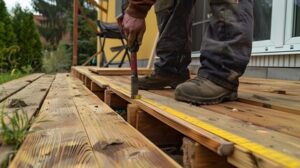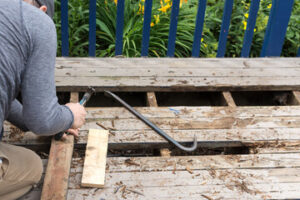Deck repair has come a long way, with a focus on durability and longevity. Contractors offer warranties and guarantees to help homeowners feel confident in their work.

Performing a thorough inspection of your deck is essential to maintain its integrity. Check for loose or rotting boards and railings. If structural problems are found, it may be best to replace the entire deck. Contact Deck Builders Lexington KY for professional help.
A variety of factors affect the cost of deck repair. Some are related to the extent of the repairs and others are related to the overall project scope. For example, a deck that spans the entire back of a house will require more materials and labor than a smaller deck. Furthermore, the location of your home impacts the costs as certain areas are more prone to rain or other weather conditions that can damage a deck. Finally, the type of decking material influences costs as different materials have different costs, durability, and maintenance needs.
The most common deck repairs are fixing loose or damaged boards and railings. Loose boards can be a serious safety risk and need to be repaired as soon as possible. Additionally, if the boards are rotting or splintering, they need to be replaced immediately. If these issues are addressed promptly, the repair costs will be relatively low.
Other repairs include repairing or replacing the deck railings, which can be expensive depending on the size and design of the deck. For instance, cable or composite railings are more expensive than traditional wooden railings. However, they offer greater durability and are less prone to wear. Additionally, repairing or replacing the deck balusters can be costly as they are typically installed in groups.
Labor costs are a significant portion of the total repair costs, especially if you hire a professional to complete the work. It is best to get quotes from several contractors before hiring someone. Moreover, the cost of labor may increase if the job is complex or requires specific skills.
Some repairs might require a permit, which will add to the overall cost of the project. Depending on your location, you might also need to pay for inspections and testing. Lastly, if your deck is significantly damaged, it might be better to invest in a new deck instead of trying to repair it. This will ensure safety and longevity and save you money in the long run.
A reputable contractor can provide you with a detailed repair quote and an estimate of the associated costs. In addition, they can help you determine whether your deck is salvageable and recommend the right course of action.
Materials
There are many different types of materials needed for deck repair, depending on the type and extent of damage. These materials include wood boards, composite or PVC boards, and joist hangers and post anchors. In addition, you’ll need other materials such as screws and lag bolts to fasten the deck together. It’s important to keep in mind that the cost of repairing a deck can add up quickly, so it’s best to purchase the required materials before beginning work.
The first step in the deck repair process is to thoroughly inspect the existing deck and determine the extent of damage. This will help you understand whether the damage can be repaired or if it requires replacement. It is also important to look for any signs of rot, mold, or mildew, as these can be dangerous. You should also check for loose or unstable components, such as deck boards and railings. It is possible to replace these components if necessary, but this will require some carpentry skills and may require hiring a professional.
In some cases, your deck may require structural repairs like re-staining or replacing joists. In these situations, it’s best to hire a professional deck contractor who can handle the task safely and efficiently.
When choosing materials for your deck repair, be sure to consider their thermal movement and live load deflection properties. This will ensure that the repair is safe and will perform well under stress. A traditional cementitious bag mix material that is used in a home improvement application, such as concrete patching or swimming pool repair, will typically have high compressive strength but can have very different coefficients of thermal expansion (CTE) and modulus of elasticity (MOE).
When comparing products, make sure you are getting the best value for your money. A good quality product will save you time, money, and frustration in the long run. Dura-Fix flexible wood epoxy is an excellent choice because it can flex with the natural shifts in wood caused by changes in temperature and humidity. This flexibility will prevent stress points from forming within the repaired area, saving you money on future repairs. It also uses eco-friendly ingredients, reducing its impact on the environment.
Time
The time it takes to repair a deck depends on the condition of the deck and whether you need to make structural or cosmetic changes. A thorough inspection is the first step. It helps you understand the scope of the work and determine if a repair is sufficient or if a complete rebuild is needed. It’s also important to prepare your tools before you begin. Having the right equipment will save you time and money in the long run. Some tools you might need include a hammer, screwdrivers, pry bar, deck fasteners, and a circular saw.
A splintered, rotten deck isn’t just unattractive, but it can also be dangerous for people who use it. It’s a good idea to hire a professional to assess the condition of the deck before you make any repairs. A thorough assessment can help you avoid major problems in the future.
During the evaluation, pay attention to common issues such as wood rot and loose boards. It’s also crucial to check the ledger board, which attaches the deck to your house. If you notice any signs of deterioration, it’s a good idea to replace it immediately. Inspecting the substructure will also reveal any damage or signs of water leaks.
A damaged deck can also cause problems with the surrounding landscaping and structure of your home. It’s a good idea to inspect the area for any rot or mold that may have affected the plants, as well as for any termite or wasp nests.
You should also look for loose nails, screws, and bolts. They’re likely to become loose due to frequent use and weather fluctuations. If these fasteners aren’t tightened, it can lead to structural damage over time. You can use a screwdriver to test the integrity of the wood by sinking it into the surface. If the tip easily penetrates the wood, it’s a sign that the deck needs repair or replacement.
You should also check the deck railings and stairs for stability. Stability issues are often caused by rust or corroded hardware and can result in injuries. It’s also important to ensure that the railings are secured with appropriate anchors and follow international residential code guidelines for lag-screwing and through-bolting.
Experience
If your deck is starting to show signs of wear and tear, you may need a professional to help you repair or replace it. A deck repair company can help you fix problems with the structure and the boards, sand and stain it, and apply protective coatings. They can also inspect your deck for hidden damage that may be causing structural issues. They can provide you with a detailed report and recommendations on what to do next.
A good deck repair company should be able to give you a quote for the cost of the project before they begin work. The price will depend on the size and type of deck, as well as the materials used. A large deck built from high-end materials such as composite or ipe will cost more than a smaller deck made from traditional wood. The size and complexity of the project can also affect the price, as some repairs require more skill and time to complete.
Whether your deck needs to be repaired or replaced depends on the extent of the damage and how it affects safety. For example, if your deck has a lot of rot and is unstable or unsafe to walk on, it might be time for a replacement. If the rot is limited to one area, repairs may be sufficient.
Another important factor to consider is the condition of the deck’s substructure. This includes the concrete footings, the wood posts, and the joists that support the decking. Rotted wood may have soft spots or dark areas and will usually feel spongy. You can test for rot by pricking the wood with a screwdriver or other probe. If it splinters, the wood is rotten and should be replaced.
A professional deck builder or repairman will have the necessary training and experience to repair your deck properly. They will also have the right tools and equipment to complete the job quickly and efficiently. In addition, they will have a lot of practical experience with carpentry, painting, construction, and home maintenance. This will ensure that your deck is in great shape for years to come.
